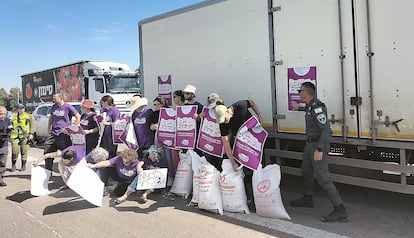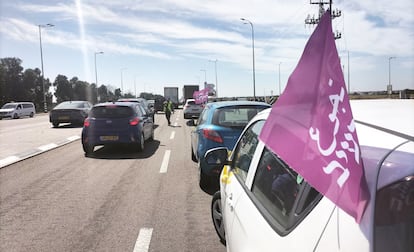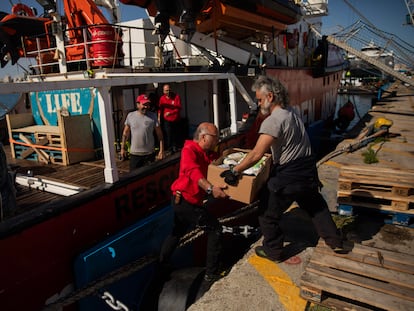Israelis criticize a local NGO for bringing aid to Gaza: ‘Aren’t you Jews?’
A pacifist organization is attacked for its failed attempt to transport food into the Palestinian enclave. Most of the population believes that humanitarian assistance ends up in the hands of Hamas


In a shopping center next to the Israeli city of Ashkelon, a woman rolls down her car window when she sees a truck and a caravan of cars. She doesn’t realize that it is an initiative — more symbolic than practical — of the Israeli pacifist NGO Omdim Beyahad (Standing Together) to bring supplies into Gaza.
When told it’s not a demonstration, but humanitarian aid, she mistakenly thinks that it is one of the small but frequent protests in the Israeli to prevent aid from entering Gaza, describing the assistance to the Palestinian territory as “shameful.”
Ashkelon is the Israeli NGO’s first stop of its trip from Tel Aviv to its destination, 80 miles further south: Kerem Shalom, the only land crossing in Israel through which food and medicine can enter Gaza. This is where all shipments are inspected. The NGO’s initiative is just made up of a truck carrying rice, flour and cans of food (donated by hundreds of Israelis) and about 20 activist cars, but their slogan in Hebrew and Arabic — “thou shalt not starve,” a play on words with The 10 Commandments — does not sit well with the feeling in Israel since the October 7 attacks.
The promoters of the campaign are aware that the police will cut them off before they reach Kerem Shalom, just as they did last Thursday, when they made their first attempt. But for the group, more than anything, the campaign is about sending a message to Israelis, the majority of whom oppose the entry of humanitarian aid to Gaza.
The group’s message is seen as betrayal, and there are tense scenes when the convoy stops at a gas station next to Kibbutz Magen, an area close to Gaza that was attacked on October 7.
– “This store was burned on October 7. You can’t stop here with those ideas. You have to understand that people died here,” says a resident of the kibbutz who everyone knows as Fiko.
– “We are only here to pick up people, it is not a provocation,” responds one of the activists.
– “I don’t believe that. Tell me their names. Nobody in this area is going to join you,” the residents hits back.
Another woman approaches to insult them and asks a border police officer: “Have you seen these shameless people?” “Yes, we just came to sort that out, what scoundrels,” the agent responds.
The police officer is one of those who shortly after, about two miles from the crossing, forces the caravan to turn around and chases them out of the area. He also repeatedly threatens to arrest the journalist for being in a “closed military zone” (he is not) when he hears that he is Spanish.
The members of the caravan turn around and park on the roadside in the other direction. A driver sees their slogan, gets out of a truck and shouts at them to leave immediately. “Is that for them [Gazans]? Are you helping them? Aren’t you Jews?” he yells.

Five months after the Hamas attacks, in which around 1,200 people were killed and more than 240 were taken hostage, the entry of humanitarian aid into Gaza has become a thorny issue in Israel — a problem made clear by the hostile response to the Israeli NGO.
Last month, a survey by the Israel Democracy Institute asked participants: “Do you support or oppose the idea that Israel should allow the transfer of humanitarian aid to Gaza residents at this time, with food and medicines being transferred by international bodies that are not linked to Hamas or to [the U.N. agency for Palestinian refugees] UNRWA?” A total of 68% of Jewish respondents said they were opposed, including 31% of those who described themselves as left-wing. In conversations and debates, attitudes range from blaming Hamas or the U.N. to claiming Gazan children are the “terrorists of tomorrow.”
Opposition to the entry of humanitarian aid into Gaza is fueled by the much-repeated claim that Hamas keeps the assistance. Up to 60%, Israeli Prime Minister Benjamin Netanyahu stated in a press conference. Added to this is the perception that aid can be used as leverage, to pressure for the release of the more than 130 hostages still captive in Gaza. Both in the first ceasefire in November and in the talks for a second one, increasing humanitarian aid is conditioned upon the release of the hostages.
Collective punishment
Aware of this hostility, activists in the Israeli NGO put out messages that could resonate with Israelis. When one of the leaders of the pacifist collective, Uri Weltmann, criticizes the “collective punishment” and the “policy of starving” the population of Gaza, he is quick to add that limiting food also puts the lives of the hostages at risk. The group shares these messages with those criticize their work, but it is of little use: today in Israel, empathy is seen as a zero-sum game and many view all of Gaza as a kind of abstract enemy.
The toughest positions are held by Israeli ultranationalists who have been demonstrating in Ashdod, one of the main ports in the country, or in Kerem Shalom. For weeks, they have been trying to stop humanitarian aid trucks from entering Gaza. And they had had some success. This prompted U.S. Secretary of State Antony Blinken to warn that Israel does not have “a license to dehumunize others.” Speaking at a press conference in Tel Aviv in February, Blinken argued: “The overwhelming majority of people in Gaza had nothing to do with the attacks of October 7 [...] They’re mothers and fathers, sons and daughters.”
At the end of January, Israeli authorities declared Kerem Shalom a “closed military zone” and the protests — which have been allowed to continue within limitations — have become a kind of cat and mouse game. In one of them, an Israeli protester told the Palestinian driving one of the aid trucks: “I am the owner of this place. You are a slave here.”
The port of Ashdod, one of the scenes of the protests, is the natural entry point for humanitarian aid to Gaza. It is where aid entered the Palestinian territory before the war. For Israelis, there is a difference between seeing humanitarian aid brought in across the country and watching it fall into Gaza by parachute or on board the NGO Open Arms ship on television.
Until now, almost all aid has been entering through Rafah or Kerem Shalom and is distributed amid the chaos caused by the Israeli invasion. The Hamas government police have little control over areas, and Israeli soldiers are not protecting the shipments either. There is a shortage of trucks, a lack of security, and both hungry crowds and armed mobs have attacked the deliveries of humanitarian aid. The U.N. insists the land route for aid is key to preventing starvation in Gaza, where more than half a million people are “one step” from famine. The Gaza Health Ministry, which is controlled by the Hamas government, estimates that 27 people have recently died in hospitals due to starvation or malnutrition, 23 of them children. More than 31,300 people have died as a result of the Israeli offensive in Gaza, according to local health authorities.
Faced with growing pressure, the Israeli army announced on Tuesday “a pilot to prevent Hamas from taking over the aid.” The Israeli military said six trucks from the U.N. World Food Program crossed via a new gate in the Gaza border fence in the north, the area hardest hit by the food scarcity. According to reports, it was the first time in three weeks that the World Food Program was able to deliver food in the capital, for 24,000 people. The U.N. Office of Humanitarian Affairs (OCHA) claims that Israeli authorities only facilitated 25% of aid missions from the south to northern Gaza planned in February.
Sign up for our weekly newsletter to get more English-language news coverage from EL PAÍS USA Edition
Tu suscripción se está usando en otro dispositivo
¿Quieres añadir otro usuario a tu suscripción?
Si continúas leyendo en este dispositivo, no se podrá leer en el otro.
FlechaTu suscripción se está usando en otro dispositivo y solo puedes acceder a EL PAÍS desde un dispositivo a la vez.
Si quieres compartir tu cuenta, cambia tu suscripción a la modalidad Premium, así podrás añadir otro usuario. Cada uno accederá con su propia cuenta de email, lo que os permitirá personalizar vuestra experiencia en EL PAÍS.
¿Tienes una suscripción de empresa? Accede aquí para contratar más cuentas.
En el caso de no saber quién está usando tu cuenta, te recomendamos cambiar tu contraseña aquí.
Si decides continuar compartiendo tu cuenta, este mensaje se mostrará en tu dispositivo y en el de la otra persona que está usando tu cuenta de forma indefinida, afectando a tu experiencia de lectura. Puedes consultar aquí los términos y condiciones de la suscripción digital.
More information
Archived In
Últimas noticias
Most viewed
- Sinaloa Cartel war is taking its toll on Los Chapitos
- Oona Chaplin: ‘I told James Cameron that I was living in a treehouse and starting a permaculture project with a friend’
- Reinhard Genzel, Nobel laureate in physics: ‘One-minute videos will never give you the truth’
- Why the price of coffee has skyrocketed: from Brazilian plantations to specialty coffee houses
- Silver prices are going crazy: This is what’s fueling the rally










































